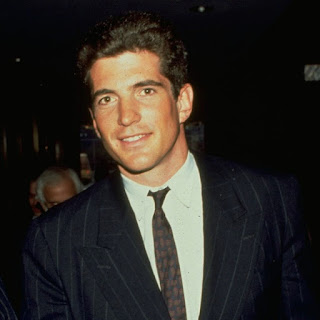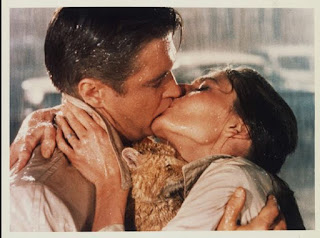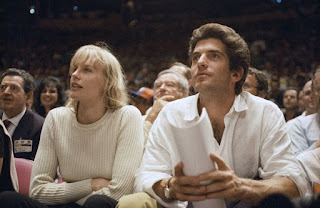
John Kennedy Jr. often spoke about the stresses endured by any woman photographed with him. These pressures were embodied by his wife; photos of Bessette, looking haunted and hunted, clutching her Calvin Klein coat protectively around her while the press pack chased behind, became as much a staple of the 90s New York tabloids as gossip about who Jerry Seinfeld was dating. Kennedy had found, somehow, a woman as beautiful as he was, who managed to make even the dreariest of clothes – beige skirts, small sunglasses – look absurdly elegant. Yet she hated the attention that came with being a Kennedy, and who could blame her? On 16 July 1999, they lived out the most Kennedy destiny of all, dying young when he crashed the plane they were flying in, with Bessette’s sister Lauren, en route to a cousin’s wedding. I watched the news coverage the next day, and the only positive thing anyone could say was, “Thank God his mother didn’t live to see this.” John Kennedy told USA Today in 1998: "The only person I've been able to get to go up with me, who looks forward to it as much as I do, is my wife. The second it was legal, she came up with me. Whenever we want to get away, we can just get in a plane and fly off."

Two years ago, Q Anon types were adamant that John Kennedy Jr. would emerge from hiding and be Donald Trump’s VP pick for the 2020 election. Spoiler: didn’t happen. But – and I swear this is the only time you’ll hear this phrase from me – Q Anon were on to something here. Kennedy and Trump are each other’s yin and yang, two sides to a very New York coin, blessed with absurd opportunities because of their families. The 2016 election will never make any sense to me, but maybe, I now think, my brain softened from a year of lockdown, it was always meant to be that a telegenic quasi-celebrity with a famous name would win the presidency that year. It’s just that we got the wrong one. I have a weakness for alternative histories that play on the idea of fixing a past wrong: Quentin Tarantino’s fantasy about saving Sharon Tate in Once Upon a Time… in Hollywood; or Doctor Who showing Vincent van Gogh how beloved he would one day be. Preventing the Kennedy Sr assassination is the ultimate alt-history fantasy, because his murder has long been seen by many as a downward turning point in American history, a theory mined by Stephen King’s novel 11/22/63. The Kennedy family will, to Americans, always represent a golden promise that was never realised. And what else is there to do, when the present feels so much bleaker than the bright future you were promised in the past, but to sit on the sofa and think: what if, what if, what if? Source: www.theguardian.com

John F. Kennedy Jr., unlike PEOPLE’S previous selections as Sexiest Man of the Year—Mel Gibson, Mark Harmon and Harry Hamlin—isn’t a professional actor. He doesn’t make his living by being on public display. The folks around him argue that he is a private citizen, and his mother, Jacqueline Onassis, has gone to some lengths to keep the press away from her family. The nation has followed his life through his studies at Phillips Academy in Andover, Mass., and on through Brown University, from which he graduated in 1983 with a B.A. in history. When did we first notice his social conscience? You really don’t care about his work for his aunt Jean Kennedy Smith’s Very Special Arts program for people with learning disabilities, or that he’s considered a friendly, decent, remarkably down-to-earth guy who once followed a stranger down the street to return the five bucks the man had dropped? There were some “obnoxious types” in the Phi Psi fraternity house, an old frat brother says, “but John wasn’t one of them. At Brown he was very undercover, and he didn’t have any attitude.” He lives on the Upper West Side of Manhattan, in a messy, book-filled apartment. He prefers to get around, even in winter, on his bike. He’s been an amateur actor since college, and when he goes for a hamburger at his favorite spot, Jackson Hole on Columbus Avenue and 85th Street, he sprawls at an outside table.

It is not merely his looks—his mother’s dark eyes and his father’s striking body. (He’s 6’1″ 187 lbs.) It is that he has something that no film star, no athlete, can duplicate—the aura, the excitement that charges a room when he enters it, simply by virtue of being Kennedy. The energy, however, hasn’t inflated his ego. “I used to pay my rent to the 42nd Street Development Corporation, which was co-founded by Jackie Onassis,” says Manhattan restaurateur Jean-Claude Baker. “JFK Jr. was in the office once, wearing big Texas boots with his feet up on the desk. When he saw me, he stood up and said very politely, ‘Yes, can I help you?’ There is no arrogance in the guy.” Although privately he was nervous, his introduction of Senator Kennedy at the Democratic convention got a two-minute standing ovation. “I can’t remember a word of the speech,” says conservative Republican consultant Richard Viguerie, “but I do remember a good delivery. I think it was a plus for the Democrats and the boy. He is strikingly handsome.” During his summer job at the law firm (one of its founding partners was Ted Kennedy’s law school roommate), JFK Jr. did not, like some summer associates, turn down assignments. He worked, according to one attorney, on “anything he was given.”

As yet unlike his father and grandfather, who were legendary ladies’ men, JFK Jr. has long relationships with his girlfriends. His steady for the last two years has been another Brown alumna, Christina Haag, 27, daughter of a marketing executive. A graduate of the upper-crusty Brearley School in Manhattan, Christina has known Kennedy since they were both 15. She too is Catholic; like Kennedy, she loves to keep in shape. They’ve acted together, playing the young lovers in Brian Friel’s Winners at Manhattan’s Irish Arts Center in 1985. This summer, when Haag appeared in a one-act comedy, Sleeping with the Past, at Hollywood’s Tiffany Theater, she and JFK Jr. shared a house in Venice. “They bring out the best in each other,” says Robin Saex, the play’s director and one of Christina’s closest friends. He was also spotted a few times with Click model Audra Avizienis, 22. “We’ve been on a few dates, but I’m not seeing him,” says Avizienis. “I’m not a girlfriend. He has a girlfriend. Or have they broken up?” Did she find young Kennedy sexy? “Oh, yes,” she says. “He has this quiet sadness. There’s something pensive and sad about him.” —Victoria Balfour for People magazine, first published on September 12, 1988.

John Kennedy Jr’s work with the underprivileged and disabled, his experience bridging the public and private sectors, his inquisitive mind, sense of obligation, and determination to avoid the obvious, a quick run for elective office, reveal a commendable sense of purpose. “He makes good decisions, not facile ones,” says a New York University School of Law pal named Stevelman. Friends say that now, though John rarely brings up his father, he is gracious when others do. Nevertheless, awkward moments do occur. “One time he was hanging out in somebody’s room,” recalls a fraternity brother, “and they were playing the Stones’ ‘Sympathy for the Devil’ (which contains the lyric, “I shouted out, ‘Who killed the Kennedys?’ / When after all / it was you and me”). Everyone realized, ‘Uh-oh.’ But at some point, he’d just walked out and then he walked back in again. He just avoided the situation.” Friends are careful with him. “It’s never come up and I wouldn’t bring it up,” says Stevelman. It’s not that he won’t want our votes eventually. He just doesn’t want them now, when all he would be is JFK II. But John F. Kennedy Jr. will always be America’s son, and that’s a hurdle he’ll face for the rest of his life. “I honestly think,” says one friend, “in 100 years, they’ll say that whatever he did, he succeeded not because he was John F. Kennedy Jr. but in spite of it.” —Michael Gross for New York Magazine, originally published in March 20, 1989

A federal judge refused to send a legal battle over a “Breakfast At Tiffany’s” remake back to state court, despite pleas by attorneys for writer Truman Capote’s trust that they mistakenly alleged copyright infringement. Paramount Pictures has designs on producing a feature film or television series remake of “Breakfast At Tiffany’s,” the 1961 classic starring Audrey Hepburn, and has a screenplay ready for the reboot. The film was based on the novella of the same name, which Truman Capote wrote in 1958. After his death, domestic property rights to the novella transferred from Paramount to the Truman Capote Literary Trust, a charity Capote established before his death. In 1991, the charitable trust entered into a settlement with Paramount granting certain rights for an eventual remake of the classic film. The controversy in the current legal battle arises from the parties’ differing interpretations of the 1991 agreement. Paramount claims the agreement granted it full rights to the novella and allows the studio to produce a “Breakfast At Tiffany’s” remake at any time. The trust has received seven-figure offers for a television series remake of the novella, the lawsuit said, adding that Paramount executives are allegedly also hip to the idea and hope to pitch a series to a streaming platform. Source: www.courthousenews.com

Breakfast at Tiffany’s is the tale of the romantic misadventures of two gold-diggers, Holly Golightly and her upstairs neighbor, Paul Varjak, both of whom are skating through their 20s by having sex with and taking money from older and richer people. Of course, they both maintain their self-respect by keeping a discreet distance between the sex-giving and money-taking, so that the quid pro quo is not too brazenly obvious. Capote said that Holly was an “American geisha.” Both Holly and Paul rationalize their choices by reference to a mission. Holly wants to buy land and horses and Paul is a writer who needs a patron to give him time to work on his great novel. But it is not working. Both show symptoms of social isolation. He’s got writer’s block. As Holly notes, he doesn’t even have a ribbon in his typewriter. Paul is the prouder and more serious of the two. Holly is top banana in the flake department. Which, of course, means that Paul suffers greatly at Holly’s hands when he falls in love with her.

The basic plot of Breakfast at Tiffany’s is quite simple. Paul Varjak—played by George Peppard at the peak of his Nordic-preppy good looks—moves into an apartment on Manhattan’s upper east side and meets his ditzy downstairs neighbor. Holly Golightly is rootless, a drifter, a flake. She has an orange cat, but she hasn’t given him a name. Her favorite place in the world is Tiffany’s, the jewelers on Fifth Avenue. She declares to Paul that if she ever finds a place that makes her feel like Tiffany’s, she’ll put down roots and give the cat a name. Paul’s apartment isn’t exactly “him” either. It looks like an expensive European hotel room. It was decorated before his arrival by his patron, Mrs. Failenson, nicknamed “2E,” played by a radiant Patricia Neal. The movie creates the character of Paul from the novel’s unnamed narrator. 2E and her relationship with Paul are inventions of the screenwriter, which considerably deepens the character and his relationship with Holly, creating dramatic conflict through “irreconcilable similarities.” For Paul, gold-digging is a short-term strategy, to get his start in life, at which time he will settle down with a nice girl and take care of her. For Holly, however, gold-digging is a long-term strategy to find a husband, who will take care of her forever.

Holly is just not Lula Mae anymore. She has constructed a whole new identity for herself. She got rid of her Okie accent with French lessons, courtesy of a Hollywood producer, Berman, and she has a fabulous circle of rich male friends—whom she rates as “rats” and “super-rats”—competing for her attention. When she sees a heartbroken Doc off at the Greyhound Bus station, she tells him that she’s a “wild thing” and that one should never fall in love with wild things, because they will just break your heart. In truth, Holly is just a flake who doesn’t know who she is or what she wants and is afraid of real relationships and real commitments. Berman thinks Holly is a phony, but he debates whether she is a real phony or not—a real phony being someone who believes his own nonsense. The whole sequence moves from creepy, to comical, to corny, to deeply moving. That’s the magic of this film. Paul now knows her story but loves her all the more. He hopes that she will get a little more serious about life, and maybe about him.

Paul enjoys taking care of Holly. It makes him feel strong and manly. Being taken care of by 2E is convenient but emasculating. Unsurprisingly, Holly proves to be the better muse than 2E. Awakening Paul’s manliness also awakens his creativity. Thus Paul is appalled when Holly declares that she is no longer going to play the field. She is going to set her sights on marrying Rusty Trawler, the ninth richest man in America under fifty, despite the fact that he is a tittering pig-faced manlet. Paul gives Holly a powerful talking to. He tells her that people really do belong to one another and that it is the only real chance we have of happiness. In today’s rabidly individualistic society, these are unfashionable sentiments, but deeply romantic and stirring ones. Paul actually reaches Holly. He actually changes her heart. She runs into the rain, searching for the cat, whom she finds, then Paul and Holly embrace, the prototype of a human family that may come to be. The end—a happy one, we hope. Unsurprisingly, modern arbiters of virtue don’t like Breakfast at Tiffany’s very much. It is obviously heteronormative, anti-feminist, and otherwise “problematic.” I highly recommend Breakfast at Tiffany’s. But what is most enchanting about this film can’t be captured in prose. It simply must be seen—for the beautiful people, the iconic fashions, and its portrayal of a glamorous, safe, overwhelmingly white New York City. It's a character study that even manages to have a “message”—and a wholesome one at that. It communicates the joys and follies of youth in America at its peak—an age of seemingly infinite potential—and the necessity of finally growing up and actually taking a stand. Source: unz.com



















































